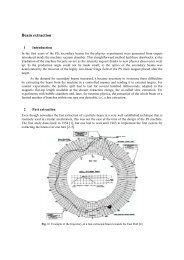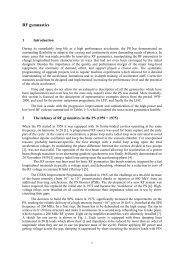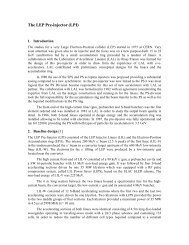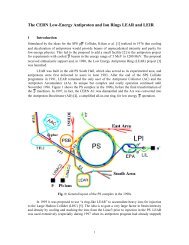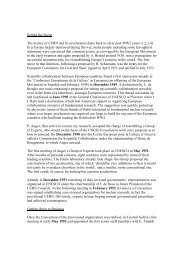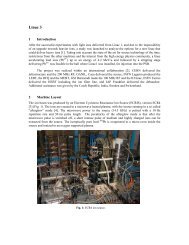The PS in the LEP injector chain - 50th anniversary of the CERN ...
The PS in the LEP injector chain - 50th anniversary of the CERN ...
The PS in the LEP injector chain - 50th anniversary of the CERN ...
Create successful ePaper yourself
Turn your PDF publications into a flip-book with our unique Google optimized e-Paper software.
Fig. 12: Possible <strong>PS</strong>–S<strong>PS</strong> transfer <strong>of</strong> eight bunches <strong>in</strong>to eight buckets. <strong>The</strong> three S<strong>PS</strong> accelerat<strong>in</strong>g systems work<br />
with <strong>the</strong> follow<strong>in</strong>g harmonic numbers: h = 2312 at 100 MHz, h = 4616 at 200 MHz, and h = 8120 at 352 MHz.<br />
No re-phas<strong>in</strong>g was needed <strong>in</strong> <strong>the</strong> <strong>PS</strong><br />
Tests <strong>of</strong> electrons and later <strong>of</strong> positrons were done on 1.2 s cycles while <strong>the</strong> <strong>PS</strong> was deliver<strong>in</strong>g<br />
beams <strong>of</strong> different particles to its o<strong>the</strong>r users, <strong>in</strong> a 14.4 s supercycle (later <strong>in</strong> a 19.2 s supercycle). It<br />
required only two <strong>in</strong>jection cycles, one positron and one electron. Acceleration <strong>of</strong> leptons was<br />
achieved on <strong>the</strong>se two consecutive 1.2 s cycles <strong>in</strong> <strong>the</strong> nom<strong>in</strong>al supercycle for <strong>LEP</strong> fill<strong>in</strong>g (see Fig. 13)<br />
[10]. Dur<strong>in</strong>g lepton acceleration <strong>in</strong> <strong>the</strong> ‘bunch expansion’ mode, <strong>the</strong> HF ferrite cavities and <strong>the</strong><br />
resonant 200 MHz cavities, normally used for proton acceleration, were respectively short-circuited<br />
and damped.<br />
Fig. 13: Dist<strong>in</strong>ctive 19.2 s <strong>PS</strong> supercycle. Positrons and electrons were accelerated on <strong>the</strong> antepenultimate and<br />
penultimate cycles<br />
<strong>The</strong> slow cycl<strong>in</strong>g, comb<strong>in</strong>ed-function <strong>PS</strong> accelerator was used as an electron accelerator besides<br />
its o<strong>the</strong>r uses as proton, antiproton, and ion synchrotron. After <strong>in</strong>itial commission<strong>in</strong>g tests it was ready<br />
to deliver electron bunches <strong>of</strong> design characteristics with better than 90% overall transmission<br />
efficiency to <strong>the</strong> S<strong>PS</strong>. Bunch length and energy spread could also be reduced by a factor <strong>of</strong> four from<br />
<strong>the</strong> nom<strong>in</strong>al values by simply decreas<strong>in</strong>g <strong>the</strong> wiggler current. Although at high <strong>in</strong>tensity (greater than<br />
2 × 10 11 electrons) transverse blow-ups were observed due to <strong>the</strong> presence <strong>of</strong> ions, <strong>the</strong> beam quality<br />
was not affected by collective effects at nom<strong>in</strong>al <strong>in</strong>tensity.<br />
14



